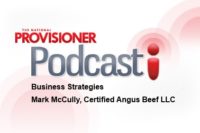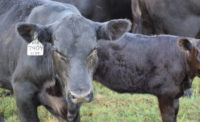Quality, safety first at Certified Angus Beef

Editor’s note: This story was supplied to The National Provisioner by Certified Angus Beef and was originally published in Food Safety Magazine.
The Certified Angus Beef® (CAB®) brand goes beyond fresh beef to add value to high-quality Angus cattle. Since its launch in 1978, demand for premium and further-processed items, such as deli meats and frankfurters, has brought more value for producers and choices for consumers.
As this innovative line progresses, staff work alongside processors to stay on the forefront of food safety, always the perfect match for fine quality.
“Third-party food safety audits and HACCP [Hazard Analysis and Critical Control Points] were useful tools from the start,” says Brett Erickson, the brand’s director of value-added products. “They gave us information about processors as well, but growing need for consumer transparency in the industry requires new insight on food safety.”
In June 2012, CAB began requiring Global Food Safety Initiative (GFSI) certification for new processors and then started working with existing processors to become approved. The program was relatively new in the United States, yet the universal code allows sharing of product and food safety information with multiple processors of all product types, plant sizes and geographic locations.
CAB staff found many processors already considering GFSI certification, most through the U.S.-based Safe Quality Food (SQF) program. Within SQF’s three tiers, the beef brand requires Level 2 certification for food safety or Level 3 with added quality management measures. Some processors who have worked through the food safety requirements are eyeing Level 3.
“We are fortunate to be associated with dedicated manufacturer-processors who embraced this opportunity to minimize risks by sharpening the food safety culture within their facilities,” Erickson says. “Once we explained how it can be benchmarked to all food safety certifications required by their customers, they wanted to know more.”
One of those processors is Hudson Meat Company in Columbus, Ohio, where brothers Dan and Jeff Emmenegger use sous vide to cook deli meats, pot roast, prime rib and short ribs. Along with the consistency gained through this slow-cooking method, most products are custom processed using customer-supplied fresh meats, offering a unique niche in the market. Many items have been CAB product since 1989, when Hudson became one of the brand’s first value-added processors.
“GFSI certification was important to us because it was important to the Certified Angus Beef brand,” says Dan Emmenegger, Hudson’s president. “Our customers were not requiring it yet but we wanted to be a step ahead of the game and open doors to new business.”
The family-owned processor was already maintaining HACCP approval, so Emmenegger was hesitant about adding costs for staff time, hiring a consultant or buying new equipment. He says the expense has been worthwhile, with a primary focus on rewording standard operating procedures to match the SQF code.
Hudson Meat finalized the desk audit in April 2014, making minor wording adjustments. The Emmeneggers also worked through a plant audit with a consultant to prepare for the official plant certification audit in May.
“We are now organized in a way that helps us level the field with large processors,” Emmenegger says. “Plus, our employees are more actively involved. They need to understand why we do what we do and will take an active role in plant audits.”
At Old World Provisions in Troy, N.Y., vice president Ross Shuket says he has gained insight to his team as well.
“We learned that when given the right tools and defined objectives [compliance with SQF code], our facilities and staff can exceed all expectations,” he says. “Becoming GFSI certified has allowed our current and potential customers to understand and believe in the work we are doing, too, and with that comes increased sales and growth.”
Shuket had also heard about the extensive amount of paperwork and the difficulty of first-time applicants to pass. “Day-to-day management of the extensive paperwork can be challenging but it holds our plants responsible and allows us to improve every day,” he says. “We wanted to make sure we were meeting and exceeding any new industry expectations, and we are.”
In Salisbury, N.C., Freirich Food Products also focuses on being a step ahead of regulations in the industry. It was an early adopter of HACCP in the 1990s, so GFSI certification seemed like a logical next step.
“Once you get to the point of passing all those third-party certifications, this didn’t require much work,” says Freirich CEO Paul Bardinas. “We refined our manual to fit within the SQF framework. The pieces were there — we just had to organize them for the new code. Now with one audit group under this umbrella, all of our customers’ needs are met.”
As CAB approaches two years into this transition, 85 percent of its manufacturer-processors are GFSI certified. More are expected to be approved this year. All are moving a step ahead of the federal Food Safety Modernization Act.
“We are pleased with our progress and appreciate their ongoing dedication to our brand,” Erickson says. “We are proud to be on the forefront with these businesses on behalf of the Angus breed.”
Founded in 1978 by Angus cattlemen, Certified Angus Beef is the only beef brand owned by the American Angus Association and its rancher members. Ten strict quality standards make it a cut above USDA Prime, Choice and Select. For details, visit www.certifiedangusbeef.com or www.cabpartners.com. Crystal Meier is the senior corporate communications manager at Certified Angus Beef LLC. For more information, contact her at cmeier@certifiedangusbeef.com.
CAB’s 10 Quality Standards
The Certified Angus Beef brand is the world’s leading Angus brand and consumers’ top choice for premium beef. Its stringent standards promise superior flavor, juiciness and tenderness.
“Angus” on a label does not define product quality. Angus is simply a breed of cattle, and Angus cattle can produce U.S. Department of Agriculture (USDA) Prime, Choice and Select beef. The Certified Angus Beef brand starts with high-quality Angus cattle that then must pass 10 science-based specifications to deliver great taste. These quality standards are what set the Certified Angus Beef brand apart.
Independent USDA graders evaluate and “certify” beef for the brand, ensuring its genuine quality. A unique system that monitors product from USDA certification to restaurants and grocery stores helps ensure consumers receive the brand’s notable quality.
The brand’s specifications address marbling, maturity and consistency – all of which play an important role in providing a great eating experience. Here’s the science that makes the Certified Angus Beef brand abundantly flavorful, incredibly tender and naturally juicy:
Superior marbling and maturity
1. Modest or higher marbling — for the taste the ensures customer satisfaction
2. Medium to fine marbling texture — the white “flecks of flavor” in the beef that ensure consistent flavor and juiciness in every bite
3. “A” Maturity — the youngest classification of product delivers superior color, texture and tenderness
Consistent sizing
Three specifications ensure uniform, consistent steak size and plate presentation:
4. 10- to 16-square-inch ribeye area
5. Less than 1,000-pound carcass weight
6. Less than 1 inch external fat
Fresh beef appearance and tenderness
7. Superior beef muscling — restricts the influence of less-tender dairy cattle
8. Practically free of capillary rupture — ensures the most visually appealing steak
9. No dark cutters — ensures the most visually appealing steak
10. No neck hump exceeding 2 inches — safeguards against cattle with variability in tenderness
Source: www.certifiedangusbeef.com
Looking for a reprint of this article?
From high-res PDFs to custom plaques, order your copy today!







